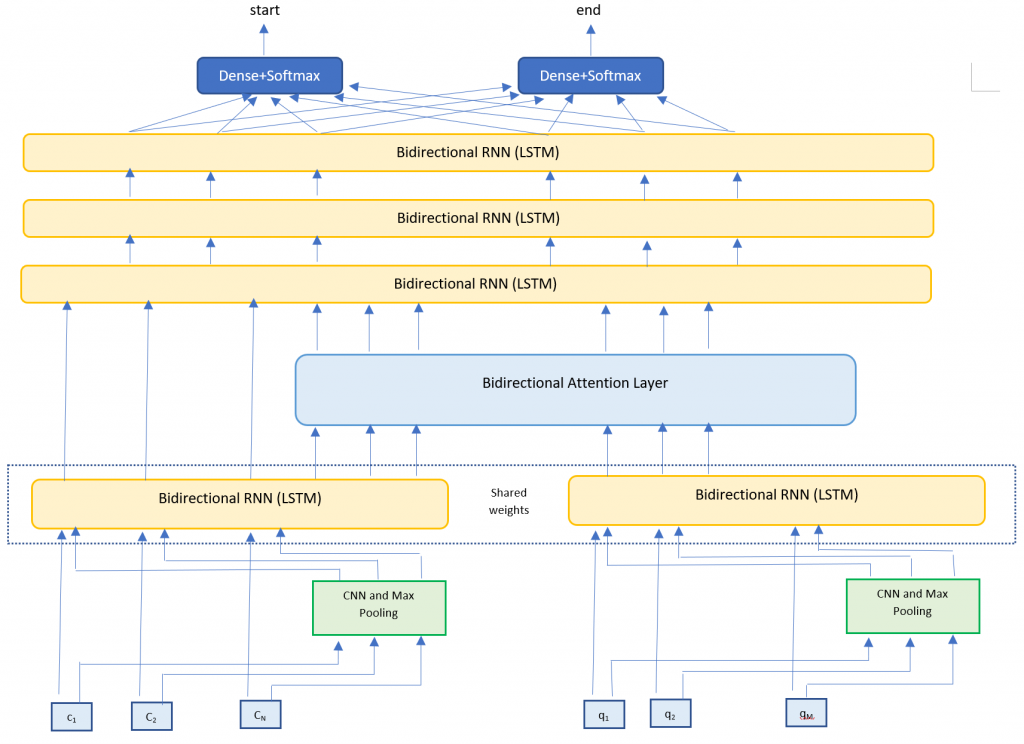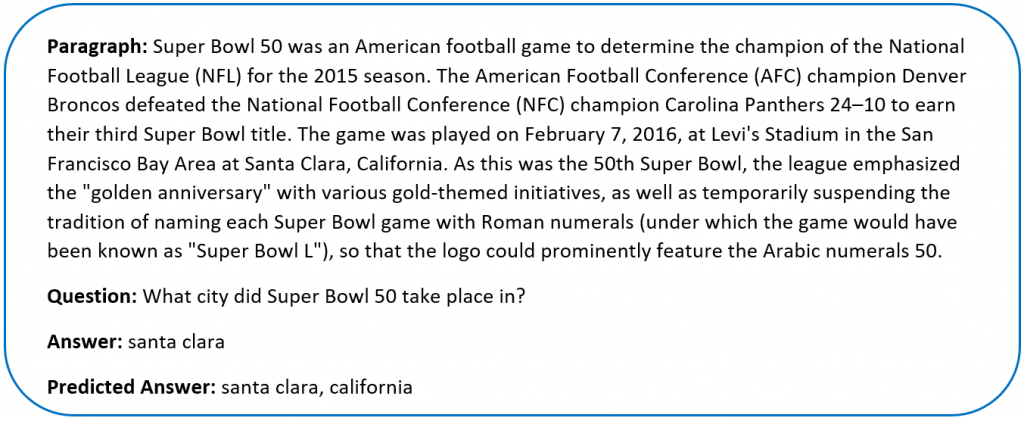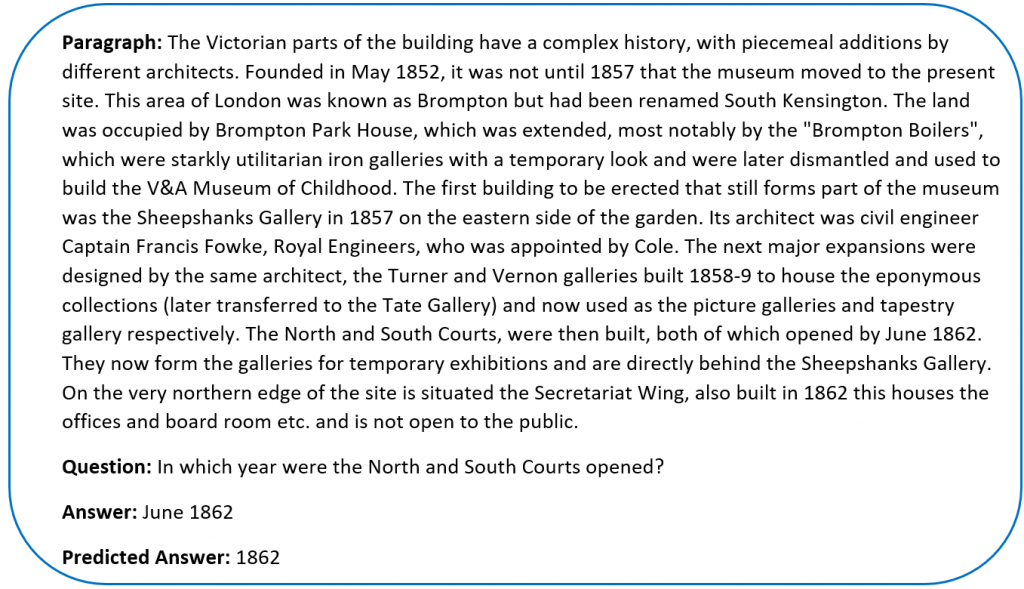The SQuAD Challenge
Machine Comprehension on the
Stanford Question Answering Dataset
Over the past few years have seen some significant advances in NLP tasks like Named Entity Recognition [1], Part of Speech Tagging [2] and Sentiment Analysis [3]. Deep learning architectures have replaced conventional Machine Learning approaches with impressive results. However, reading comprehension remains a challenging task for machine learning [4][5]. The system has to be able to model complex interactions between the paragraph and question. Only recently have we seen models come close to human level accuracy (based on certain metrics for a specific, constrained task). For this paper I implemented the Bidirectional Attention Flow model [6], using pretrained word vectors and training my own character level embeddings. Both these were combined and passed through multiple deep learning layers to generated a query aware context representation of the paragraph text. My model achieved 76.553% F1 and 66.401% EM on the test set.
Introduction
2014 saw some of the first scientific papers on using neural networks for machine translation (Bahdanau, et al [7], Kyunghyun et al [8], Sutskever, et al [9]). Since then we have seen an explosion in research leading to advances in Sequence to Sequence models, multilingual neural machine translation, text summarization and sequence labeling.
Machine comprehension evaluates a machine’s understanding by posing a series of reading comprehension questions and associated text, where the answer to each question can be found only in its associated text [5]. Machine comprehension has been a difficult problem to solve – a paragraph would typically contain multiple sentences and Recurrent Neural Networks are known to have problems with long term dependencies. Even though LSTMs and GRUs address the exploding/vanishing gradients RNNs experience, they too struggle in practice. Using just the last hidden state to make predictions means that the final hidden state must encode all the information about a long word sequence. Another problem has been the lack of large datasets that deep learning models need in order to show their potential. MCTest [10] has 500 paragraphs and only 2,000 questions.
Rajpurkar, et al addressed the data issue by creating the SQuAD dataset in 2016 [11]. SQuAD uses articles sourced from Wikipedia and has more than 100,000 questions. The labelled data was obtained by crowdsourcing on Amazon Mechanical Turk – three human responses were taken for each answer and the official evaluation takes the maximum F1 and EM scores for each one.
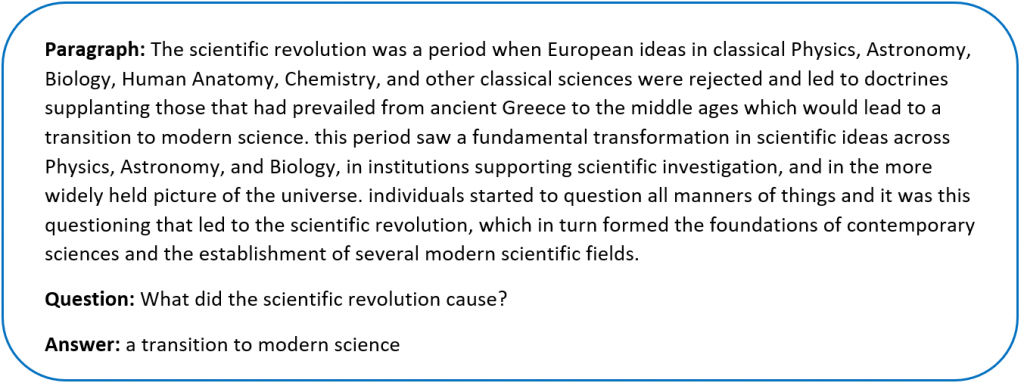
Sample SQuAD dataSince the release of SQuAD new research has pushed the boundaries of machine comprehension systems. Most of these use some form of Attention Mechanism [6][12][13] which tell the decoder layer to “attend” to specific parts of the source sentence at each step. Attention mechanisms address the problem of trying to encode the entire sequence into a final hidden state.
Formally we can define the task as follows – given a context paragraph c, a question q we need to predict the answer span by predicting (astart,aend) which are start and end indices of the context text where the answer lies.
For this project I implemented the Bidirectional Attention Flow model [6] – a hierarchical multi-stage model that has performed very well on the SQuAD dataset. I trained my own character vectors [15][16], and used pretrained Glove embeddings [14] for the word vectors. My final submission was a single model – ensemble models would typically yield better results but the complexity of my model meant longer training times.
Related Work
Since its introduction in June 2016, the SQuAD dataset has seen lots of research teams working on the challenge. There is a leaderboard maintained at https://rajpurkar.github.io/SQuAD-explorer/. Submissions since Jan 2018 have beaten human accuracy on one of the metrics (Microsoft Research, Alibaba and Google Brain are on this list at the time of writing this paper). Most of these models use some form of attention mechanism and ensemble multiple models.
For example, the R-Net by Microsoft Research [12] is a high performing SQuAD model. They use word and character embeddings along with Self-Matching attention. The Dynamic Coattention Network [13], another high performing SQuAD model uses coattention.
Approach
My model architecture is very closely based on the BiDAF model [6]. I implemented the following layers
- Embedding layer – Maps words to high dimensional vectors. The embedding layer is applied separately to both the context and question text. I used two methods
- Word embeddings – Maps each word to pretrained vectors. I used 300 dimensional GloVE vectors.
- Character embeddings – Maps each word to character embedding and run them through multiple layers of Convolutions and Max Pooling layers. I trained my own character embeddings due to challenges with the dataset.
- RNN Encoder layer – Takes the context and question embeddings and runs each one through a Bi-Directional RNN (LSTM). The Bi-RNNs share weights in order to enrich the context-question relationship.
- Attention Layer – Calculates the BiDirectional attention flow (Context to Query attention and Query to Context attention). We concatenate this with the context embeddings.
- Modeling Layer – Runs the attention and context layers through multiple layers of Bi-Directional RNNs (LSTMs)
- Output layer – Runs the output of the Modeling Layer through two fully connected layers to calculate the start and end indices of the answer span.
Dataset
The dataset for this project was SQuAD – a reading comprehension dataset. SQuAD uses articles sourced from Wikipedia and has more than 100,000 questions. Our task is to find the answer span within the paragraph text that answers the questions.
The sentences (all converted to lowercase) are tokenized into words using nltk. The words are then converted into high dimensional vector embeddings using Glove. The characters for each word are also converted into character embeddings and then run through a series of convolutions neural network and max pooling layers. I ran some analysis on the word and character counts in the dataset to better understand what model parameters to use.
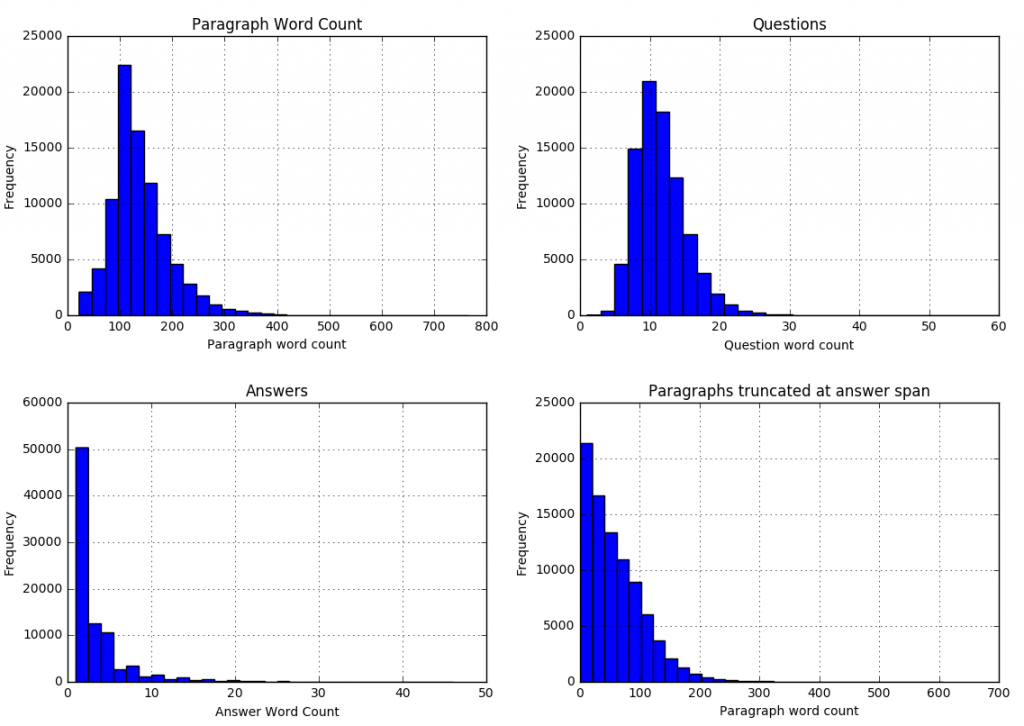 We can see that
We can see that
| 99.8 percent of paragraphs are under 400 words |
| 99.9 percent of questions are under 30 words |
| 99 percent of answers are under 20 words (97.6 under 15 words) |
| 99.9 percent of answer spans lie within first 300 paragraph words |
We can use these statistics to adjust our model parameters (described in the next section).
For the character level encodings, I did an analysis of the character vocabulary in the training text. We had 1,258 unique characters. Since we are using Wikipedia for our training set, many articles contain foreign characters.
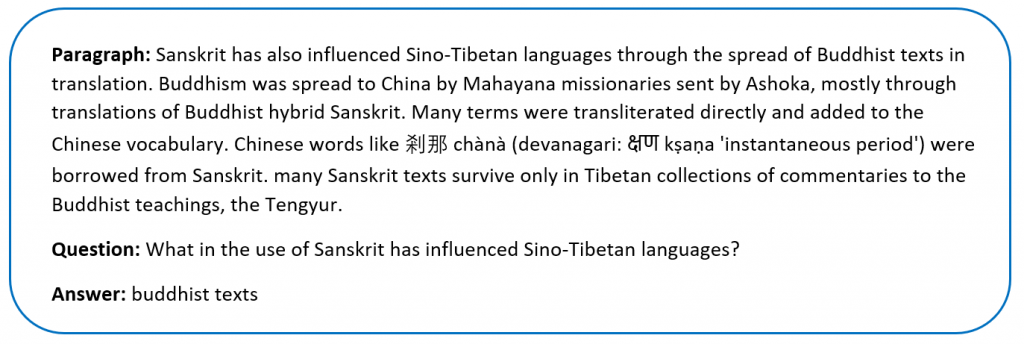
Further analysis suggested that these special characters don’t really affect the meaning of a sentence for our task, and that the answer span contained 67 unique characters. I therefore selected these 67 as my character vocabulary and replaced all the others with a special REPLACEMENT TOKEN.
Instead of using one-hot embeddings for character vectors, I trained my own character vectors on a subset of Wikipedia. I ran the word2vec algorithm at a character level to get char2vec 50 dimensional character embeddings. A t-SNE plot of the embeddings shows us results similar to word2vec.
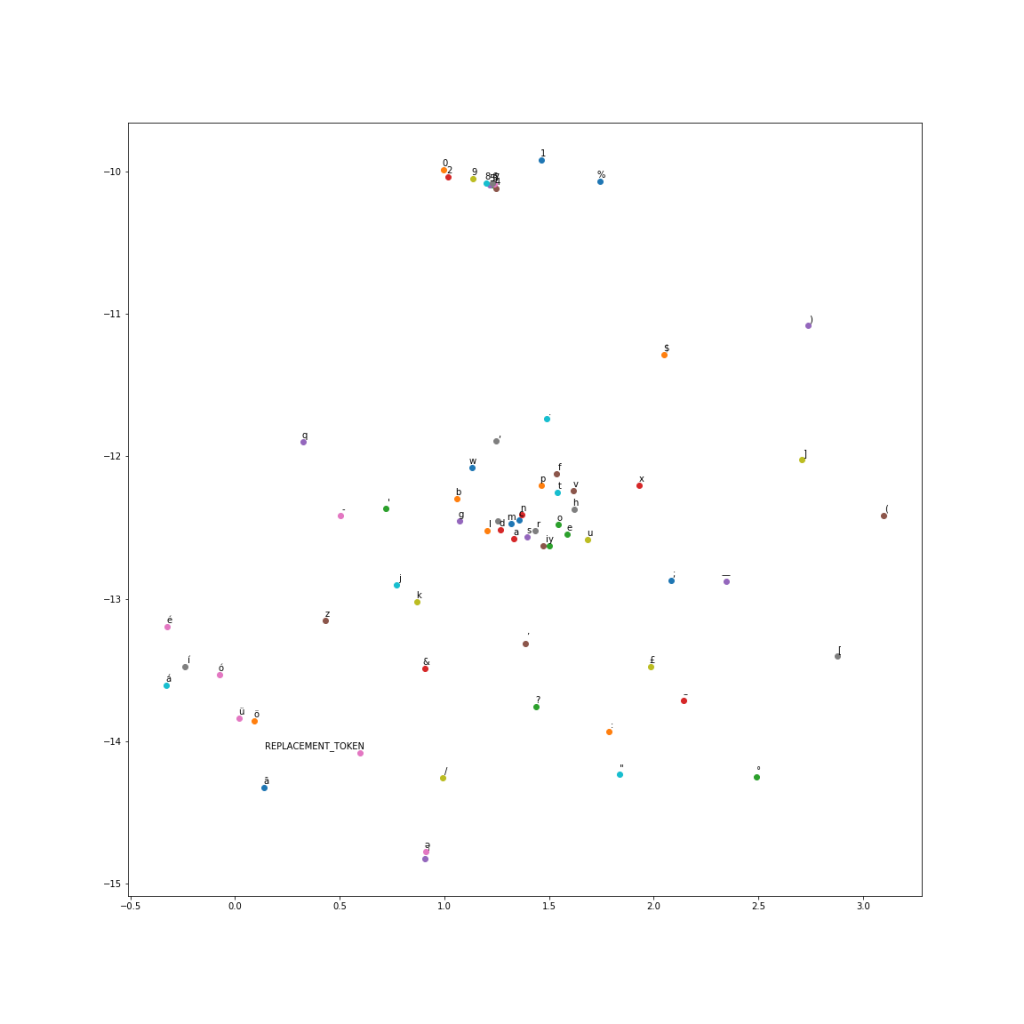 I used these trained character vectors for my character embeddings. The maximum length of a paragraph word was 37 characters, and 30 characters for a question word. Since we are using max pooling, I used these as my character dimensions and padded with zero vectors for smaller words.
I used these trained character vectors for my character embeddings. The maximum length of a paragraph word was 37 characters, and 30 characters for a question word. Since we are using max pooling, I used these as my character dimensions and padded with zero vectors for smaller words.
Model Configuration
I used the following parameters for my model. Some of these (context length, question length, etc.) were fixed based on the data analysis in the previous section. Others were set by trying different parameters to see which ones gave the best results.
| Parameter | Description | Value |
| context_len | Number of words in the paragraph input | 300 |
| question_len | Number of words in the question input | 30 |
| embedding_size | Dimension of GLoVE embeddings | 300 |
| context_char_len | Number of characters in each word for the paragraph input (zero padded) | 37 |
| question_char_len | Number of characters in each word for the question input (zero padded) | 30 |
| char_embed_size | Dimension of character embeddings | 50 |
| optimizer | Optimizer used | Adam |
| learning_rate | Learning Rate | 0.001 |
| dropout | Dropout (used one dropout rate across the network) | 0.15 |
| hidden_size | Size of hidden state vector in the Bi-Directional RNN layers | 200 |
| conv_channel_size | Number of channels in the Convolutional Neural Network | 128 |
Evaluation metric
Performance on SQuAD was measured via two metrics:
- ExactMatch (EM) – Binary measure of whether the system output matches the ground truth exactly.
- F1 – Harmonic mean of precision and recall.
Results
My model achieved the following results (I scored much higher on the Dev and Test leaderboards than on my Validation set)
| Dataset | F1 | EM |
| Train | 81.600 | 68.000 |
| Val | 69.820 | 54.930 |
| Dev | 75.509 | 65.497 |
| Test | 76.553 | 66.401 |
The original BiDAF paper had an F1 score of 77.323 and EM score of 67.947. My model scored a little lower, possibly because I am missing some details not mentioned in their paper, or I need to tweak my hyperparameters further. Also, my scores were lower running against my cross validation set vs the official competition leaderboard.
I tracked accuracy on the validation set as I added more complexity to my model. I found it interesting to understand how each additional element contributed to the overall score. Each row tracks the added complexity and scores related to adding that component.
| Model | F1 | EM |
| Baseline | 39.34 | 28.41 |
| BiDAF | 42.28 | 31.00 |
| Smart Span (adjust answer end location) | 44.61 | 31.13 |
| 1 Bi-directional RNN in Modeling Layer | 66.83 | 51.40 |
| 2 Bi-directional RNNs in Modeling Layer | 68.28 | 53.10 |
| 3 Bi-directional RNNs in Modeling Layer | 68.54 | 53.25 |
| Character CNN | 69.82 | 54.93 |
I also analyzed the questions where we scored zero on F1 and EM scores. The F1 score is more forgiving. We would have a non zero F1 if we predict even one word correctly vs any of the human responses. An analysis of questions that scored zero on the F1and EM metric were split by question type. The error rates are proportional to the distribution of the questions in the dataset.
| Question Type | Entire Dev Set (%) | F1=0 (%) | EM=0 (%) |
| what | 27.2 | 28.4 | 29.3 |
| is | 18.4 | 18.5 | 18.4 |
| did | 9.1 | 8.8 | 9.0 |
| was | 8.7 | 9.1 | 7.9 |
| do | 6.9 | 6.9 | 7.9 |
| how | 6.2 | 5.9 | 6.1 |
| who | 6.2 | 6.7 | 6.1 |
| are | 4.4 | 3.7 | 4.2 |
| which | 3.3 | 3.4 | 3.1 |
| where | 2.3 | 2.5 | 2.5 |
| when | 3.9 | 2.9 | 2.3 |
| name | 1.8 | 1.5 | 1.5 |
| why | 0.7 | 0.6 | 1.3 |
| would | 0.7 | 0.9 | 0.9 |
| whose | 0.2 | 0.2 | 0.2 |
However, there were some questions where the system was very close to the correct answer, or the correct answer was technically wrong
Conclusion
Attention mechanisms coupled with deep neural networks can achieve competitive results on Machine Comprehension. For this project I implemented the BiDirectional attention flow model. My model accuracy was very close to the original paper. In the modeling layer we discovered that deeper networks do increase accuracy, but at a steeper computational cost.
For future work I would like to explore an ensemble of models – using different deep learning layers and attention mechanisms. Looking at the leaderboard (https://rajpurkar.github.io/SQuAD-explorer/), most of the top performing models are ensembles.
